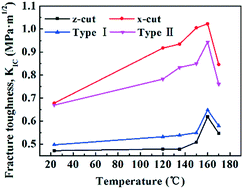A study on fracture toughness of potassium dihydrogen phosphate single crystals
Abstract
The cracking of KDP crystals during the growth & fabrication process is a serious problem that limits their application in the large-aperture high-power laser system; furthermore, the cracking is mainly attributed to their high brittleness. In order to explore the mechanical parameters related to KDP crystal cracking in detail, we measured the fracture toughness of KDP crystals as a function of temperature using the single-edge notched beam (SENB) method up to 170 °C. Meanwhile, the effects of crystallographic orientation, annealing and loading rate on the fracture toughness values were investigated in detail. Strong orientation dependence was observed on the fracture toughness of KDP crystals, and the relationship was concluded as follows: x-cut > type II > type I > z-cut. With the increase in temperature, the fracture toughness of crystals increased and reached its maximum value at 160 °C; then, it decreased, indicating that 160 °C is the temperature at which brittle-to-ductile transition occurs. Using an optical microscope, it was observed that the fractured surfaces of the samples become gradually rough with the increase in temperature. This may offer a viewpoint for understanding the dependence of fracture toughness on temperature. Furthermore, annealing and decrease in the loading rate were conducive to the significant increase in the fracture toughness of KDP crystals.



 Please wait while we load your content...
Please wait while we load your content...